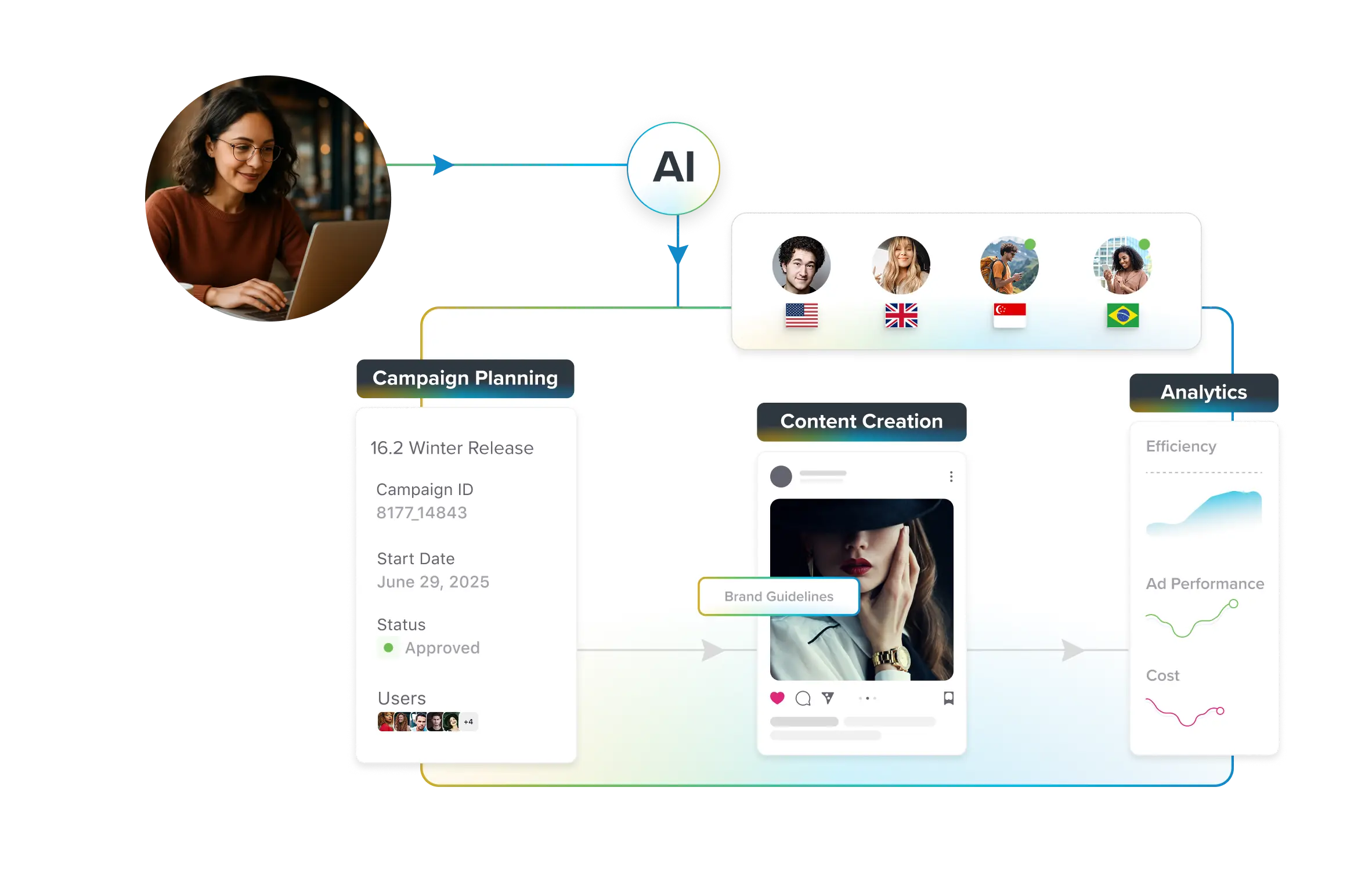The AI-native platform for global campaign management
Sprinklr Marketing unifies campaign planning, content creation, publishing and analytics across global teams — all elevated by AI. Accelerate go-to-market, boost performance and enforce brand governance at scale.

How to create a marketing automation strategy
Imagine this: as a B2B marketer, you have just published an e-book full of insight on tackling an everyday content marketing challenge and want it to generate leads and turn those leads into paying customers. But tracking and nurturing individual leads becomes time-consuming and ineffective. In such circumstances, having a marketing automation strategy in place would help you manage those interactions more efficiently.
By setting up an automated email campaign using marketing automation software, you can save time and resources while providing content tailored to your target audience. When a lead fills out a form and downloads an e-book from your website, they are automatically added to an ongoing email nurture campaign that provides additional resources and more in-depth information regarding how your company can assist with content marketing challenges on a regular basis. Automating this entire process saves time and resources while helping deliver tailored, relevant content that resonates with your target audience. Plus, by tracking key metrics such as open and click-through rates, you can optimize and refine your strategy for outstanding results in business.
Thus, marketing automation strategies help streamline your marketing efforts and drive business growth. As substantiated by Gartner, companies that implement automation for lead management see a revenue increase of 10% or higher within 6-9 months — quite an impressive impact on your bottom line!
In this blog, we will walk you through how to develop an effective marketing automation strategy, including its associated advantages, challenges and key performance indicators (KPI).
What is marketing automation?
Marketing automation refers to the use of technology to automate repetitive marketing tasks like sending emails, social media posts and ads campaigns — with the intention of saving both time and resources while providing targeted customer content at scale.
But what exactly does this look like in practice?
Imagine running an online store offering workout gear. Marketing automation enables you to set up automated email campaigns triggered by customer behavior. For instance, when someone abandons their cart you could send out an automated reminder email with special offers to encourage them back. Or following a completed order you could send out personalized recommendations of products related to ones purchased previously. By harnessing this customer data for campaigns, you can deliver content crafted to meet customer interests and needs — while continuously optimizing and refining your efforts by tracking performance metrics.
Thus, marketing automation can help your brand generate leads, nurture customer relationships and boost sales productivity — but its implementation requires careful consideration and execution.
Devising a reliable marketing automation strategy for business success
Follow these steps to develop an effective marketing automation strategy.
Step 1: Set your goals and KPIs
Step one in creating an effective marketing automation strategy is setting specific and realistic goals and KPIs in order to measure campaign success and make necessary adjustments.
How to do?
When setting these objectives, be specific and realistic. Whether that means increasing leads, improving conversion rates or increasing customer retention — just ensure they align with your overall business goals.
Once your goals have been established, it's time to establish the KPIs you will use to monitor your progress. These could include metrics such as website traffic, click-through or lead-to-customer conversion rates — any combination of these metrics will give an accurate reflection of campaign success while facilitating data-driven decisions regarding optimizing your marketing automation strategies.
Your marketing automation goals and KPIs should remain flexible over time. Once your campaign begins to roll out, certain goals might no longer apply or you may require adjusted KPIs to accurately gauge success. By regularly monitoring performance and revising goals and KPIs accordingly, you will achieve desired business outcomes more regularly.
Step 2: Understand your audience
To develop an effective marketing automation strategy, it is imperative to understand your audience. Gather insights about their behaviors, preferences and pain points using data analysis. Then tailor your messaging and campaigns according to their needs and interests for increased engagement and more conversions.
Step 3: Leverage emails to streamline communication
Email automation can be an invaluable strategy to streamline communication and increase efficiency. In order to implement it successfully, there are a few essential steps you need to take:
How to do?
- First, segment your audience based on relevant criteria like demographics or purchase history; this should help you come up with a targeted email list.
- Next, create engaging and customized email templates based on user sign-ups or abandoned carts.
- Then study your recipients’ daily routines and time zones to schedule emails according to their availability and receptiveness. This increases the chances of them being clicked, read or acted upon.
Once your email campaign has concluded, review its performance using metrics such as open and click-through rates to gauge its success, and then make necessary tweaks for continued success.
Step 4: Select appropriate marketing automation tools
There are various marketing automation tools in the market, each with their own strengths and weaknesses. So it is crucial that you conduct thorough research to select an ideal tool to fulfill your brand needs.
How to do?
- First and foremost, ease of use should be your top priority. Don't spend all your time learning how to operate an unfamiliar platform; find one with intuitive controls and user guides instead.
- Integration between tools is another essential consideration for your marketing automation tool. Your tool must seamlessly sync up with the other applications you already use — such as CRM systems and analytics platforms — making managing campaigns and understanding performance simpler than ever.
- Pricing should also be kept in mind when considering marketing automation solutions, since their costs depend heavily on features and functionalities offered. Be sure to select an affordable tool with a great return on investment.
- Customer support should also be an essential element. Look for tools with helpful resources and responsive service.
Step 5: Develop an engaging content strategy
Content creation is key to creating an effective marketing automation strategy. But you have to understand who your audience is and their interests and needs to create engaging and high-converting content.
How to do?
First step should be identifying types of media which appeal to them such as blogs posts, videos, infographics or e-books and then developing messaging which addresses pain points directly. For instance, highlighting product/service benefits or providing useful tips/advice/customer success stories to illustrate a certain pain point.
Ensuring your content adheres to both your brand guidelines and overall business goals is of critical importance. Furthermore, consider how to efficiently distribute these assets via various channels such as emails, social media or the web.
Remember, content strategies should never be set in stone. Once your campaign is launched, you may discover that certain pieces are performing better than others so you need to adjust accordingly in order to increase engagement and drive conversions. Leverage analytics to refine content strategies as and when necessary so as not to reduce engagement levels.
Step 6: Revisit campaigns and tweak them as per your needs
Now that your goals, audience insights, tools and content strategy are in order, it is time to begin implementing your campaigns.
How to do?
As your campaigns roll out, monitoring them carefully and adapting your strategy based on results is needed to ensure long-term success. This requires tracking key performance indicators (KPIs) like open rates, click-through rates and conversion rates as you make necessary adjustments.
If one of your email campaigns is underperforming, revisions might include altering its messaging or changing when and how often it is sent. Also be sure to revisit and optimize campaigns using data insights for targeting and improving your messaging. You may send drip email campaigns or create dynamic landing pages — whatever method is chosen be sure to use data analytics to optimize and improve your marketing strategy.
Benefits of automating your marketing efforts
Here are some key benefits of automating your marketing efforts:
Attracting and engaging potential customers
Automation works wonders during the decision-making process, sending reminders to users who abandoned carts or following up with leads who have expressed an interest in your product/service. But don't underestimate its power at the top of the sales funnel! Automation can provide demos or tutorials, respond to inquiries from social media users or deploy chatbots on websites — all designed to grab attention right from the beginning and engage your target audience immediately.
Converting leads into customers
Lead generation requires targeting interested leads. Now that the protocol requires consent-based advertising and cookieless tracking, automation becomes even more invaluable in turning their interest into actual purchases. You can accomplish this through well-timed emails offering irresistible discounts or limited-time offers, reminding them about abandoned carts, sweetening deals by offering bonuses or even surprising them with freebies. It goes without saying that automating conversion helps turn potential buyers into delighted customers.
Uncovering contextual and valuable insights
You know what they say: knowledge is power. The more data that comes your way from campaigns the better equipped you'll be to optimize them successfully. One of the perks of automation is that it allows you to identify key touchpoints that can greatly benefit from automated workflows. With automation, you can even gather valuable insights from different channels, whether it's analyzing traditional metrics, gathering feedback through targeted campaigns or conducting complex A/B tests. By harnessing these insights, you can not only streamline and supercharge your marketing efforts, but also create highly targeted campaigns. It’s a win-win all around.
Challenges while building your marketing automation strategy
Establishing a sound marketing automation strategy may present its own set of obstacles. Here are four common challenges to keep an eye out for:
- Data quality: Your marketing automation strategy relies heavily on data, so it's vital that it remains accurate and up-to-date.
- Integration issues: If you use multiple marketing automation tools, it can be challenging to ensure they all integrate smoothly.
- Lack of resources: Constructing an effective marketing automation strategy takes time, resources and expertise — without which executing it may prove difficult.
- Over-automation: Balancing automation with human interaction is key when automating marketing. Over-automation could result in impersonal, irrelevant messages that fail to reflect your brand values.

KPIs to measure the impact of marketing automation
Measuring the impact of your marketing automation strategy is critical to realize your business goals. Here are a few key performance indicators (KPIs) you need to track.
- Conversion rate: measures the percentage of visitors who take an intended action such as buying something or filling out a form
- Engagement rate: tracks how many people are engaging with your content through email opens, clicks or comments on social media posts
- Lead quality: assesses the quality of leads you generate for your business by tracking metrics like lead score, sales qualified leads (SQLs) and follow-up conversion rates
- Revenue generation: this is one of the value metrics to understand if your marketing automation strategy is performing well or not. Evaluate how much revenue automation is generating for your company.
Final thoughts
Now that you have an excellent grasp on marketing automation, how it operates and its potential advantages for your brand, don’t just stop there! The marketing field is constantly undergoing transformation, making it necessary to remain up-to-date on industry trends and best practices — marketing automation included. Keep pushing the envelope in terms of what's possible through automation; perhaps one day you could be leading the new marketing revolution.
With Sprinklr Marketing, you can bring down content production costs by as much as 50%, boost campaign effectiveness by over 30%, and reduce brand and compliance risks and redundant manual tasks by 25%.
